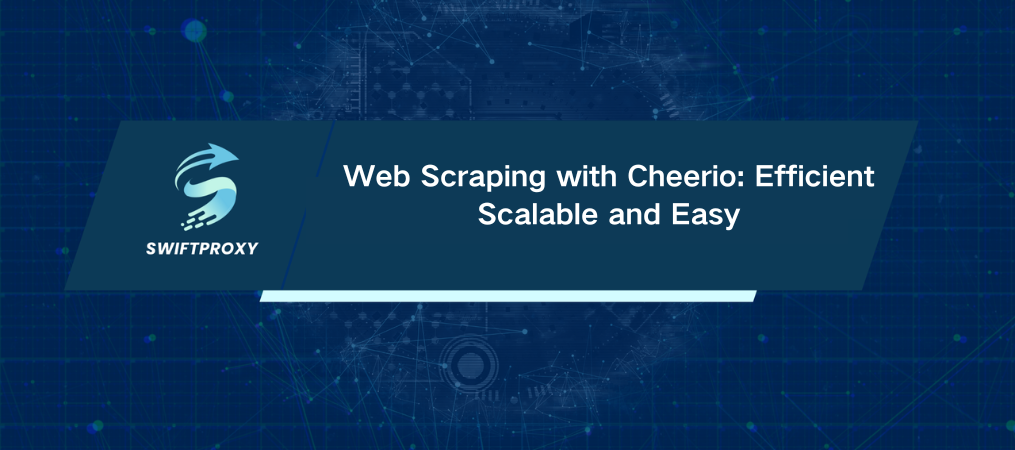Web Scraping with Cheerio: Efficient Scalable and Easy

Web scraping is a game-changer in today's data-driven world. Whether you're gathering market intelligence or building content aggregation tools, understanding how to efficiently extract data from websites is a must. And if you're looking for a powerful yet lightweight tool, Cheerio paired with Node.js is the secret weapon you need. Let's dive in.
Why Web Scraping
In a world where data reigns supreme, web scraping is a tool that every developer and business should know. It allows you to extract structured data from websites automatically, which can be used for:
Market Research: Track competitor pricing, customer sentiment, and industry trends.
SEO Tracking: Analyze keyword rankings and search engine performance.
Content Aggregation: Collect and organize information from multiple sources.
Data Analysis: Extract valuable insights from public datasets.
But like any powerful tool, web scraping comes with its challenges—legal issues, CAPTCHA protection, and anti-bot systems, to name a few. Ethical scraping isn't just a good practice, it's a necessity. Always respect a website's robots.txt file and collect data responsibly.
Why Cheerio for Web Scraping
Cheerio is a standout choice when it comes to web scraping with Node.js. This lightweight library allows you to parse HTML quickly and efficiently—without the overhead of running a full browser. But what makes it really stand out?
Speed & Efficiency: No browser required—Cheerio's pure JavaScript approach makes it lightning-fast.
Minimal Resource Consumption: It's perfect for scraping without draining your resources.
Familiar Syntax: If you're comfortable with jQuery, you'll love Cheerio's easy-to-use syntax for navigating the DOM.
Ideal for Static Pages: It's perfect for scraping HTML content from pages that don't rely on JavaScript for rendering.
However, if you're dealing with JavaScript-heavy sites, Cheerio might not be enough. In those cases, tools like Playwright or Puppeteer that emulate a browser environment will do the trick.
Preparing Your Web Scraping Environment
Here's how you can kick off your web scraping with Cheerio.
Install Node.js: Download the latest version from Node.js and follow the installation steps.
Build a Project: Open your terminal and run npm init -y to set up a new Node.js project.
Install Dependencies: Cheerio and Axios are your best friends here. Run:
npm install cheerio axios
Axios handles HTTP requests to fetch web pages, while Cheerio parses the content for easy data extraction.
Example: Scraping an E-commerce Site
Let's scrape product titles and prices from an e-commerce website.
Fetching the Web Page:
const axios = require('axios');
const cheerio = require('cheerio');
async function fetchHTML(url) {
try {
const { data } = await axios.get(url);
return data;
} catch (error) {
console.error('Error fetching page:', error);
}
}
This snippet fetches the raw HTML from the target URL. If successful, the HTML is returned. If not, an error is logged.
Parsing the HTML and Extracting Data:
async function scrapeData(url) {
const html = await fetchHTML(url);
const $ = cheerio.load(html); // Load the HTML into Cheerio
const products = [];
$('.product-item').each((_, element) => {
const title = $(element).find('.product-title').text().trim();
const price = $(element).find('.product-price').text().trim();
products.push({ title, price });
});
console.log(products);
}
scrapeData('https://example.com');
Here, we loop through all product items, extract their title and price, and log the data.
Advanced Techniques for Better Scraping
Now that you've got the basics down, let's explore some advanced techniques to take your scraping to the next level.
Handling Pagination:
Scraping multi-page sites? This snippet handles pagination by dynamically creating URLs for each page:
async function scrapeMultiplePages(baseURL, totalPages) {
for (let i = 1; i <= totalPages; i++) {
const pageURL = \`${baseURL}?page=${i}\`;
await scrapeData(pageURL);
}
}
scrapeMultiplePages('https://example.com/products', 5);
It iterates through each page and scrapes the data.
JavaScript-Rendered Content:
When dealing with pages that rely on JavaScript, use Playwright to fetch the fully rendered HTML:
const { chromium } = require('playwright');
async function scrapeWithBrowser(url) {
const browser = await chromium.launch();
const page = await browser.newPage();
await page.goto(url);
const content = await page.content();
console.log(content);
await browser.close();
}
scrapeWithBrowser('https://example.com');
Playwright simulates a real browser, making it easier to scrape JavaScript-heavy sites.
Error Handling:
Always handle errors gracefully to prevent your scraper from crashing:
async function safeFetchHTML(url) {
try {
const { data } = await axios.get(url, { timeout: 5000 });
return data;
} catch (error) {
console.error(\`Error fetching $ {url}:\`, error.message);
return null;
}
}
Optimizing Your Scraping
Efficiency is key. Here are some optimization tips to help you streamline your scraping process:
Optimize Selectors: Use precise CSS selectors to target only the necessary elements. The more specific you are, the faster your scraper will run.
Reduce Redundant Requests: Cache repeated requests to save time and resources.
Asynchronous Processing: Use Node.js's async/await to handle multiple requests concurrently.
Monitor Resource Usage: Keep an eye on memory, CPU, and network usage to avoid performance bottlenecks.
Best Practices for Ethical Scraping
Scraping can be a powerful tool, but it must be done responsibly. Follow these guidelines to ensure your projects remain compliant and ethical:
Respect Robots.txt: Always check a site's robots.txt file to see which pages can be scraped.
Don’t Violate ToS: Make sure your scraping activities don't violate a site's Terms of Service.
Rate Limit Your Requests: Insert delays between requests to mimic natural browsing behavior and avoid being blocked.
Proxy Management: Use rotating proxies to bypass IP bans and CAPTCHA challenges.
Final Thoughts
Cheerio is a versatile, powerful tool for extracting data from static web pages. Whether you're gathering market research or monitoring SEO, Cheerio's simplicity and speed make it the go-to choice for many developers.
As you grow your web scraping projects, don't forget to follow best practices—both technically and ethically. With the knowledge in this guide, you're equipped to tackle a wide range of scraping challenges with confidence.

















































